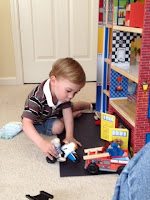Sunday, August 5, 2012
Doll House vs. Fire Station
In this post I’m going to be bringing together a number of different themes (and not signing with babies, for a change) that are salient in research on early child development: Sex differences in choice of toys; the fact that girls learn to talk on average earlier than boys, and the relationship between different types of play and language development. And I’m going to do all this by highlighting a a photo I took last week while taking care of my twin grandchildren, Nate and Olivia.
• First, sex differences in choice of toys: From the time they were old enough to make choices for themselves, it’s been clear (despite efforts from parents and grandparents to the contrary) that Nate was in love with anything with wheels and vroom-vroom noises and Olivia with anything pink, purple, and with the word “princess” or “baby” in the title. In fact, one of the most recent of Olivia’s favorites is a large pink and white plastic doll house complete with pink and white frilly furniture and a pink clad baby. Needless to say, Nate is not equally enchanted.
• Second, sex differences in verbal development: One of the most robust of all differences between boys and girls is the fact that—on average—girls learn to talk earlier than boys. (Note. This is true for learning words, but not signs. No sex difference there.)
• Third, relationship between types of play and verbal development: Dr. Susan Goodwyn and I discovered a number of years ago that pretend play, in contrast to manipulative play (where the child just moves pieces in some way—like shape sorters, hammers and peg boards, puzzles), helps facilitate language development. There are a number of reasons why, but the main one is because pretend play involves so much language itself! The child is thinking and often explaining out loud pieces of some kind of simple plot, either alone or in response to questions from adults. Susan and I suspect that one of the reasons boys lag behind girls in language is because the toys they are typically given (with some exceptions to be sure) are less likely to inspire pretending than the baby dolls, tea sets, and doll houses typically given girls.
So, how do these three observations relate to the photo above? Take a close look at the nature of the toy Nate is playing with. It is, in fact, a miniature structure. But instead of being a typical “doll house” like Olivia’s, it’s a pretend fire station. It has many of the same things Olivia’s does--a kitchen (firefighters have to eat after all), bathroom, bedroom and living area—but it also has a pole to slide down, a treadmill, an elevator, a fire truck, and a heliport! My point is that it has characteristics that Nate, like lots of little boys, value while at the same time promoting the type of play (i.e., pretending) that is so good for language development. And he loves it! I stood and watched him play for a long time and was amazed at the imaginary scenarios he was describing in words, both to himself and in explanation to me.
The lesson in all this is directed at parents and grandparents as they think about appropriate toys. Simply, keep in mind that pretending is critical to both boys and girls and that sex difference in preferences for pretend scenarios are often a fact of life, but that with a bit of creative thinking on our own parts, it’s possible to satisfy both requirements.
Happy Signing (and don’t forget to visit us on Facebook)!
Linda
Linda Acredolo, Ph.D.
Professor Emeritus, UC Davis
and
Co-Founder, The Baby Signs® Program
Subscribe to:
Post Comments (Atom)


1 comment:
Nice article, thanks for sharing.
Post a Comment